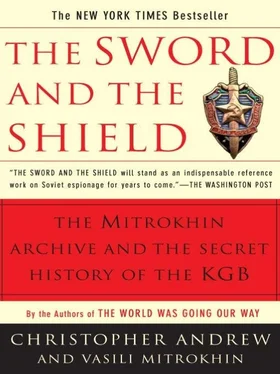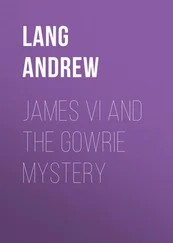The Italian authorities failed to discover Moro’s hiding place in time. On May 9, 1978 he was murdered by his kidnappers and his body left in the boot of a car in the center of Rome, midway between the headquarters of the PCI and those of the Christian Democrats. In the outpouring of grief and soul-searching which followed Moro’s assassination there was—to the relief of the Direzione—no mention of the involvement of the StB with the Red Brigades. During the police hunt for terrorist radio stations over the next few years, however, the PCI leadership became increasingly anxious that their own might be discovered. In June 1981 the PCI leadership informed the Rome residency that, for security reasons, the three radio stations installed by the KGB for clandestine Party use eight years earlier had been destroyed. 26
The Soviet invasion of Afghanistan at the end of 1979 and the imposition of martial law in Poland two years later destroyed any semblance of a reconciliation between Moscow and the PCI. At a meeting of the PCI Central Committee in January 1982, only the KGB’s main contact voted against a motion condemning Soviet interference in Polish affairs. Berlinguer declared that the October Revolution had “exhausted its propulsive force,” implying in effect that the CPSU had lost its revolutionary credentials. The Direzione called on the west European left to work for the “democratic renewal” of the countries of the Soviet Bloc. Pravda denounced the PCI’s declarations as “truly blasphemous.” There followed what the Italians called lo strappo— a brief but highly polemical breach of relations between the PCI and CPSU.
Within the Italian Party leadership, the hardliner Armando Cossutta was a lone voice in taking Moscow’s side in the quarrel. 27A decade later, as the Soviet Union was disintegrating, evidence leaked out that Soviet subsidies to the PCI had continued on a reduced scale in the 1980s. But, according to one commentator, “It soon became clear that if Soviet funds had been channelled into Italy, they went through the hands… of Cossutta, either to shore up a failing newspaper with pro-Soviet sympathies ( Paese Sera ) or to help finance his own activities against the PCI’s leaders.” 28The final recorded payments—700,000 dollars in 1985, 600,000 dollars in 1986 and 630,000 dollars in 1987—were used solely to provide “material support” to what the CPSU International Department and the KGB (but probably not Gorbachev) considered “the healthy forces in the PCI,” chief among them Cossutta and Paese Sera. 29
BERLINGUER APART, THE Eurocommunist of whom Moscow was most suspicious was Santiago Carrillo, leader of the PCE (Partido Comunista de España). Even as a teenage militant, Carrillo had shown precocious leadership qualities. In 1936, at the age of only nineteen, mocked by his opponents as “the chrysalis in spectacles,” he engineered a fusion between the socialist and communist youth movements and became chairman of the combined organization. During the Spanish Civil War, Carrillo became a close friend of the celebrated NKVD illegal, saboteur and assassin Iosif Grigulevich, whom he subsequently chose as his son’s secular “godfather.” 30Taking refuge in Moscow in 1939 after Franco’s victory in Spain, Carrillo proved his Stalinist orthodoxy by denouncing his own father, to whom he wrote with self-righteous fanaticism, “Between a Communist and a traitor there can be no relations of any kind.” He later claimed, implausibly, “If there was any fear of Stalin in the Soviet Union, I did not see it. For many years only a minority knew about the trials and the purges.” 31
After becoming general secretary of the exiled PCE in 1959, however, Carrillo gradually evolved towards Eurocommunism. In 1968 the PCE executive committee condemned Soviet intervention in Czechoslovakia; its leading Soviet loyalists, Agustín Gómez, Eduardo García and General Enrique Líster, were expelled in 1969-70. 32In July 1975 the PCI and PCE jointly issued a “solemn declaration that their conception of the march towards socialism in peace and freedom expresses not a tactical attitude but a strategic conviction.” After Franco’s death in November, Carrillo began to plan the PCE’s reemergence as a legal party. Late in 1976, without informing Moscow, he returned secretly to Spain from his French headquarters. On December 6 the Centre sent an urgent telegram to the Madrid residency, telling it to investigate rumors that Carrillo was in Spain and, if so, to find out whether he had returned on his own initiative or after a secret agreement with the Christian Democrat prime minister, Adolfo Suárez. 33
In fact Carrillo had returned in order to try to force Suárez’s hand. On December 10 he gave a public news conference, thus compelling the Prime Minister to decide whether to risk the wrath of the army and the right by legalizing the PCE or to risk alienating the main democratic parties by refusing to do so. Though Carrillo was arrested on December 22, he was set at liberty a few days later and met secretly with Suárez. The formal legalization of the PCE followed in April 1977. 34
Just as in Italy, the KGB’s principal point of contact with the PCI was with a Soviet loyalist, so the Madrid residency’s main source within the PCE was the most pro-Soviet member of its executive committee, Ignacio Gallego, codenamed KOBO. Until March 1976 Soviet subsidies to the PCE had been forwarded via the French Communist Party, the PCF. By Politburo decision no. P-1/84 of March 16, however, the KGB was instructed to make payments directly to Gallego. At least some of these payments were intended for Gallego himself, rather than the PCE executive as a whole, so that he could “work on his contacts.” On December 6, 1976 the Politburo approved a payment to Gallego of 20,000 dollars (decision no. P37/39-OP) for the purchase of a flat in Madrid. Though his public criticism of Carrillo was muted, the Madrid residency reported that in private Gallego was bitterly critical, denouncing him as “a danger to the Spanish Communist Party and the international Communist movement.” 35
Early in 1977, through his wife LORA, Gallego passed on to the Madrid residency Carrillo’s draft of a joint declaration to be issued at a summit meeting of the leaders of the PCE, PCI and PCF, as well as the proofs of Carrillo’s forthcoming book, “Eurocomunismo” y Estado (“ Eurocommunism ” and the State ). 36The Centre was scandalized by the criticisms in both documents of the Soviet Union—though, in the event, Berlinguer and Georges Marchais, general secretary of the PCF, rejected the most trenchant passages of the draft communiqué. 37Gallego informed the KGB that the left-wing daily Pueblo planned to send a correspondent to Moscow to interview Soviet dissidents. Thus forewarned, the Madrid embassy refused the correspondent a visa. 38
With the restoration of parliamentary democracy for the first time since the Spanish Civil War, the PCE was widely expected—not least by Carrillo—to achieve as dominant a position on the left in Spain as the PCI had in Italy. Its socialist rival, the PSOE, had adapted itself less well both to underground opposition to the autocratic Franco regime and to maintaining party organization during almost forty years of exile. In the 35-year-old Felipe González, however, the socialists had a dynamic, telegenic leader whose youthful appeal to voters was far more effective than Carrillo’s. During the campaign for the parliamentary elections of June 1977 the PCE also found it more difficult than the PSOE to free itself of an extremist image. To Moscow’s satisfaction, Carrillo’s Eurocommunist campaign was at least mildly disrupted by the return from the Soviet Union in May of the 83-year-old president of the PCE, Dolores Ibárruri, whom Carrillo had succeeded as general secretary almost twenty years earlier. Known as La Pasionaria (“passion flower”), Ibárruri had been the most charismatic orator of the Civil War, famous around the world for her cries of defiance in the face of fascism: “Better to die on your feet than live on your knees!”; “Better to be the widow of a hero than the wife of a coward!” Franco’s supporters spread rumors that she had once cut a priest’s throat with her own teeth. 39Though Ibárruri’s appearances during the 1977 election campaign were limited by her age and weak heart, she lost no opportunity to praise the achievements of the Soviet Bloc—“countries where socialism is being built.” Carrillo tried to dilute the impact of her speeches by implying that she was out of touch and bound to the Soviet Union by the death of her only son while fighting for the Red Army at Stalingrad.
Читать дальше











